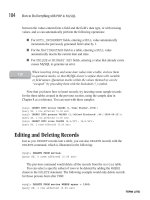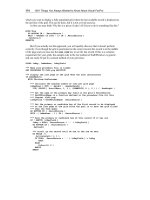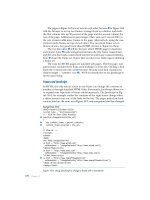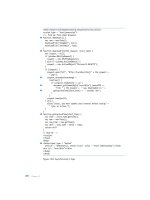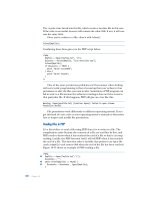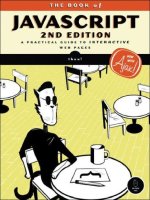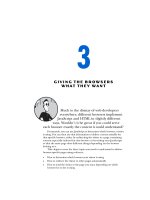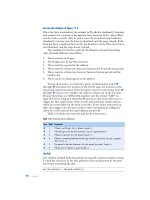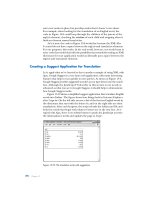Introduction to Forensic Sciences 2nd Edition phần 5 pps
Bạn đang xem bản rút gọn của tài liệu. Xem và tải ngay bản đầy đủ của tài liệu tại đây (7.48 MB, 38 trang )
are not like the slowly drawn, awkward, stop-and-go, inconsistent pen move-
ments and divergent letter formations produced by a forger trying to imitate
the writing of someone else. But, differentiating poorly written genuine
writing features from the defective writing features of forgery is not always
easy or possible. Success depends on many factors, such as the volume of
the questioned writing, the volume of the exemplar writing and its closeness
in date to the questioned writing, and the conditions under which the
questioned and exemplar writings were written. These features of genuine
writing and forged writing help examiners answer Questions 1 and 2 that
follow.
The Examining Process
Using the unaided eye in combination with the microscope, the examiner
compares the obvious and the inconspicuous writing features in the ques-
tioned writing with the writing features in the exemplar writing. These fea-
tures include letter shapes, letter sizes, letter heights, the height relationships
of letters, writing slant, the direction and shape of beginning and terminal
strokes, letter connections, letter disconnections, pen pressure, and smooth-
ness of pen movement. In brief, the examiner compares all of the features
that make up the questioned writing and the exemplar writing.
The examiner looks for combinations of significant similarities and com-
binations of significant differences between the questioned writing and the
exemplar writing. If the examiner finds combinations of significant similar-
ities between the questioned and exemplar writing and if there occur no
significant differences, then it becomes increasingly likely that the questioned
writing and the exemplar writing were written by the same person. At the
end of the study, after all of the evidence has been evaluated, the examiner
might conclude that the person who wrote the exemplars was in fact the
person who wrote the questioned writing, or in the case of a questioned
signature, that the questioned signature is genuine.
But if combinations of significant differences exist between the ques-
tioned writing and exemplar writing and if the typical features of forgery
exist in the questioned writing, then the examiner might conclude that the
questioned writing was not written by the exemplar writer or, in the case of
a questioned signature, that the signature is not genuine. These sound like
simple principles, do they not? Well, the principles are simple and sound.
But applying the principles and their exceptions is far from simple.
Note the terms “significant similarities” and “significant differences”.
These are subjective terms, are they not? They most certainly are. So who
ultimately determines just what is significant and what is not? The examiner,
of course. So when making handwriting comparisons, how do examiners
©1997 CRC Press LLC
objectively and accurately decide which features serve as significant similarities,
which serve as significant differences, and which are not significant at all?
These decisions come from the examiner’s knowledge and understanding
of class characteristics, individual characteristics, and all the forces that can
affect the way we write. And to repeat once more, this knowledge and under-
standing come from supervised training and much practical experience.
There will be times when examiners cannot give definite answers. They
will have to report, “I do not know.” And that inconclusive statement is not
an answer that investigators and clients like to hear. But sometimes the
available handwriting evidence will not permit a definite yes or no answer,
as in the case of disguised writing or when too few or inappropriate exemplars
are submitted.
In some cases, the examiner might decide that the evidence warrants
more than just the inconclusive, “I do not know.” So the conclusion might
be reported as a degree of probability, such as, “It is highly probable that the
John Doe signature is genuine.” Or, with a lesser degree of probability, “The
John Doe signature is probably genuine.”
Reporting or testifying in varying degrees of probability can be a dan-
gerous and misleading business. Report readers and jurors can easily misun-
derstand the examiner’s specific meaning of “highly probable” or “probably”
or any other terms that embrace degrees of probability. So the examiner must
make it very clear in the report’s wording or in courtroom testimony that
the conclusion is less than certain. Reporting in degrees of probability is truly
a subjective gray area. Thus, probability reporting demands very precise,
nonambiguous explanations of the examiner’s conclusion.
Witnesses in court who can qualify as expert are granted the extraordi-
nary privilege of expressing their opinions (conclusions) based on their
examinations of the evidence. But, an expert opinion is not the same as a
best guess. Guessing (lawyers call it speculation, a conclusion without sup-
portive demonstrable evidence) absolutely does not belong in written report-
ing or in testimony.
Reporting or testifying in varying degrees of probability must never be
used to pacify a client or as a camouflage for what really is only the examiner’s
best guess. A probability opinion must never be used to avoid having to
report the unwelcome, nonhelpful inconclusive opinion. But, be aware, there
are those who take the position that any expert testimony or written conclu-
sions that embody degrees of probability are nothing more than best guesses.
If the examiner chooses to use a probability opinion rather than an incon-
clusive opinion, then the examiner must be prepared to demonstrate why
the probability conclusion is more objective and more appropriate than, “I
do not know.”
©1997 CRC Press LLC
Some Document Problems and How They Are Solved
Can document examiners answer all of the following 40 questions all the
time? No. But many of the questions can be answered most of the time.
Useful answers, of course, depend on the quality of the evidence and the skill,
training, experience, and tools of the examiner.
It must be remembered that document examiners can evaluate only the
evidence that is submitted. The examiner cannot use hearsay evidence, police
reports, eyewitness statements, confessions, admissions, knowledge of other
examiners’ opinions, signed statements, or even notary affidavits, as elements
for forming conclusions. Only the submitted physical evidence as evaluated by
the examiner can serve as a basis for the examiner’s own reports or testimony.
Following each of the first 23 questions is a brief discussion on how the
problem might be solved. Each discussion does not, of course, reflect all the
ways that the problem might be solved. Solving the problem (answering the
question) can require many approaches combined with the examiner’s expe-
rience, tools, and innovative skills.
1. Is the signature on this document genuine or is it an imitation
(forgery)?
2. Who wrote the signature or other writing on this document?
Document examiners spend much of their time trying to answer these
two questions because most document problems are handwriting problems.
Figure 9.1 shows a forgery on a fraudulent contract. The victim’s wife
was tricked into signing this contract while it was blank. The victim’s own
signature was then forged to complete the fraud. In Figure 9.1 you can see
tremor and awkward, stop-and-go pen movements in the victim’s first name,
“Walter”. These defects are the typical features of forgery. The victim’s last
name also showed the same features of forgery.
Figure 9.2 shows the victim’s genuine (exemplar) writing. Note the
smooth-flowing pen movement in the name “Walter”. The victim’s exemplar
signatures (on canceled checks and other legitimate documents in this same
business deal) showed no tremor, no pen lifts, no unnatural stops and starts.
Figure 9.2 shows the typical features of genuine natural handwriting. The
examiner’s photo exhibits helped to convince the jury that the questioned
signature was in fact not written by the victim.
When a writer (forger) attempts to imitate the writing of someone else
(either by tracing or freehand copying), the forger’s own identifying hand-
writing features are usually eliminated in the forging process. Thus, the writer
of the Figure 9.1 forgery could not be identified.
©1997 CRC Press LLC
With regard to Question 2, questioned writings can appear on an infinite
variety of documents, such as anonymous notes, purported suicide notes,
business records, drug dealers’ records, gambling records, medical records,
and diaries. Identifying their author can be successful if (a) combinations of
unique identifying similarities are found to exist between the questioned
Figure 9.1
Figure 9.2
©1997 CRC Press LLC
writing and the exemplar writing, and (b) no significant differences are found
to exist between the questioned writing and the exemplars. And, the typical
pen movement features of forgery, such as pen lifts at unnatural places, slow
tremulous pen movements, and pen strokes that are added in order to repair
or correct the forger’s mistakes, must be absent in the questioned writing.
Successful (reliable) identifications depend on the amount of questioned
writing, the amount of appropriate exemplars, the circumstances under
which the questioned writings and the exemplars were written, and of course
the training and experience of the examiner.
3. Can this suspect be eliminated as the writer of the questioned
writing?
Differences that are found to exist between questioned writings and
exemplars do not always signal that the exemplar writer should be eliminated
as the writer of the questioned material. Differences can be contrived in the
questioned writing by the writer, as in the case of anonymous letters. Differ-
ences can be the result of awkward writing positions, writing hand weakness
due to illness, writing hand injuries, temporary eyesight injuries, and intox-
ication. Differences can occur when the exemplars themselves are deliberately
disguised by the suspect. Differences can exist because the questioned writing
and the exemplars are not of similar time periods. It should be noted that
although the writing of some people will show a dramatic change over a long
period of time, the writing of all people does not necessarily have to change.
A writer might be eliminated when it can be shown that the suspected writer
(via appropriate exemplars) did not have the natural writing skill to have
written the more graceful, skillfully written questioned writing. You are
invited to read the texts listed at the end of this chapter for an in-depth
discussion of the nuances, pitfalls, coincidences, and exceptions to the rules
that face examiners in the identification and elimination of writers.
4. Was the document signed or prepared on the document’s date?
Investigations might show that a printed form itself was not in existence on
the forms’s date. The examiner’s reference files might show that the typewriter
or printer that produced the questioned entries was not in existence on the
document’s date. The design of a manufacturer’s watermark in the document’s
paper stock might show that the design was not in existence on the document’s
date. Chemical analyses, if allowed, might show that the ink formulation (pen)
did not exist on the document’s date. But ink analyses of this kind require
extensive ink sample reference files. Very tremulous exemplar signatures of an
aged and ill person that are dated on and near the date of the questioned
©1997 CRC Press LLC
document can show that this writer did not have the physical ability to have
produced the more skillfully written questioned signature. Other features of the
questioned signature might show that it is an imitation. If the questioned sig-
nature is found to be genuine through exemplars from other dates, then the
document’s date does not reflect the writer’s writing ability on that date. Thus,
the document was not signed on the date it bears. Conversely, exemplars show-
ing good writing skill that are dated on and near the date of the questioned
document can show that the document’s tremulous genuine signature (if it is
found to be genuine) was not written on the document’s date.
5. What make of typewriter was used to produce this document?
6. Was the typewriter in existence on the document’s date?
The examiner’s reference files can help identify the specific make, or the
files may indicate several possible makes. Type styles that are similar can be
found on typewriters of several different manufacturers, so examiners must be
cautious before concluding that the questioned text was produced on a specific
make of typewriter. Examiners attempt to maintain reference files that show
type style changes that have been made at intervals by the various manufacturers.
Thus, the evidence might show that the document exhibits a style or an indi-
vidual letter or numeral design that did not exist on the document’s date.
7. Was this document prepared on the suspect’s typewriter?
Figure 9.3 shows damaged type characters: the lower case “o” and lower
case “p”. These were two of several damaged characters that were present on
a series of threatening notes. See the notch at the upper left of the “o”, and
see the upward pointed spur on the lower left serif of the “p”. These same
two defects (and others) were also present in exemplars of a suspect’s business
letter (Figure 9.4). The combinations of similar individual characteristics
(defects) existing in the questioned and exemplar texts showed that the
questioned notes had been typed on the suspect’s office typewriter. Of course,
the evidence could not identify who typed the notes. Figures 9.3 and 9.4 show
the effects of the damaged type characters on different paper surfaces.
8. Were all the entries on this document typed during the same
typing interval or were some entries added at a later time?
A specially made glass plate, scribed with horizontal and vertical lines to
form a grid, can be laid over the typewritten material to reveal alignment or
misalignment of the entries.
©1997 CRC Press LLC
For example, if the first and last typewritten lines on a contract’s page
are in perfect vertical and horizontal alignment with each other, and if a
questioned entry that appears on a line between them is not in the same
perfect alignment, the evidence shows that the questioned entry was not
typed in sequence with the first and last lines. That is, the questioned entry
was added at a later time. Typewritten questioned entries that show a ribbon
condition that is different from other entries on the document can indicate
or establish that the questioned entries and the other entries were made at
different times.
Figure 9.5 shows a portion of a certificate of deposit. It was suspected
that the name of another relative had been added (as co-owner) at a much
later time. Although the same typewriter had been used, the questioned name
(the top entry) shows a misalignment with the lower name. The top entry
also shows a cloth ribbon imprint much weaker than the lower entry. The
evidence clearly shows that the questioned upper name was added at a later
time, when the ribbon was much drier.
9. Was this document produced on this specific printer?
10. What kind of printer produced this document?
The era dominated by the manual and electric printing machines that we
have known as impact typewriters is over. Their dominance as office and home
printing machines has passed. Although we will continue to see documents
generated on manual and electric typewriters, these machines are rapidly being
Figure 9.3 Figure 9.4
©1997 CRC Press LLC
replaced in the work-place and home by new computer-controlled printers such
as impact dot-matrix printers, inkjet printers, and laser printers.
Figure 9.6 shows the dot pattern of a 9-pin dot-matrix printer; the dot
pattern serves to identify the dot-matrix printer. The dot pattern is less
discernible in the pattern produced by a 24-pin printer or when a printer is
set to “letter quality” mode rather than draft mode. The numerous pins that
produce the dot-matrix characters can develop defects. And in some cases,
the defects can be sufficiently unique to connect a questioned text to a specific
dot-matrix printer. But these pin defects develop far less frequently than do
the defects that develop in the typeface characters of impact manual type-
writers and impact electric typewriters.
Figure 9.7 shows the imprint made by an ink jet printer. The fast drying
ink is ejected onto the paper from tubes in the printer’s ink cartridge. Note
the feathered edges of the various letters caused by spattering of the ink on
impact with the paper. The paper’s surface texture can affect the amount of
spattering. This spattering is one feature that helps to identify the ink jet
printer.
Figure 9.8 was produced by a laser printer. The laser printer product is
similar to that produced by a plain paper office copy machine. An image of
the laser’s keyboard generated text is electronically created on the printer’s
drum. Powdered toner sticks to the drum where the electronic image was
formed. The toner image is transferred to plain paper and the toner is briefly
heated so that the toner fuses to the paper: the same process as a xerographic
office copy machine.
Viewed under the microscope, the printout of the laser printer is very
similar if not identical to that of an office photocopy. Thus, it can be difficult
Figure 9.5
©1997 CRC Press LLC
to discern the difference between an original document just produced on a
laser printer and a photocopy of that original.
Experience to date has shown that ink jet printers and particularly laser
printers develop few of the unique imprint defects that can connect a ques-
tioned text to one specific make or individual printer. Also, ink jet printers
and laser printers have the built-in capability of printing a multitude of
different character designs. This feature rarely permits an identification of
the printer’s manufacturer.
Figure 9.6
Figure 9.7
©1997 CRC Press LLC
In summary, successful identification of a specific make of ink-jet printer
or laser printer, or the connecting of a questioned document to a specific
ink-jet printer or laser printer is seldom possible.
11. Can this questioned photocopy be connected to one make of
copier and/or to one specific copier?
The internal paper transport mechanism of some copiers can produce
indentations and other markings on the paper as it is being transported
through and out of the machine. These class characteristics, when discernible,
can in some cases provide an identification of the copier’s manufacturer if
the examiner has appropriate reference files.
The copy machine can also produce unique and identifying defects on
the photocopies it generates. These individual characteristics (defects) can
be created by high volume use, by the careless removing of jammed paper
(producing scratches on the drum), lack of normal maintenance and repair,
and by infrequent cleaning of rollers, drum, corona wires, and platen. These
individual characteristics can appear as black or white lines across the paper,
as tiny black specks called “trashmarks”, as smudges, and a variety of other
flaws. If the examiner finds that a combination of similar defects exists
between a questioned photocopy and an exemplar photocopy made on a
suspect copier, then there might be sufficient evidence to conclude that both
were produced on the same copier.
The examiner must always be absolutely certain that the submitted ques-
tioned photocopy is in fact the
original
photocopy in question — that it is
Figure 9.8
©1997 CRC Press LLC
not a second generation photocopy made from the original questioned pho-
tocopy on an intervening copier. The intervening machine could introduce
misleading trashmarks and other defects that are not related to the investi-
gation. This same caution applies to the evaluation of the submitted exemplar
specimens.
Color copy machines have invited the counterfeiting of paper money,
stamps, bank checks, driver licenses, or any documents that will serve the
purposes of thieves. Color copies can be identified as such by a microscopic
examination of the image. The microscopic examination will disclose the
overlaying pattern of the various single colors that in turn produce the
various hues in the color image. The rib-like pattern typical of one make of
color copier is shown in Figure 9.9.
12. Have pages been substituted in this multi-page document?
13. Have pen entries been added at a later time to this document?
A page of a multi-page contract or last will and testament that shows a
manufacturer’s watermark or an ultraviolet fluorescence that is different from
accompanying pages can indicate that this page may be bogus, that it has
been substituted for the original page.
Mechanical watermarks are logos or designs impressed into paper when
it is made; they usually identify the paper’s maker. Chemical watermarks can
be put on the paper after it is made. These custom-designed chemical water-
marks can be the consumer’s own company trade name or they can be a
personal logo.
Figure 9.9
©1997 CRC Press LLC
Mechanical watermarks are sometimes coded. They are inconspicuously
marked or periodically changed by some paper makers for purposes of quality
control dating. Thus, these coded watermarks can help to show that a doc-
ument (the paper stock) was or was not in existence on the date that the
document bears. Figure 9.10 shows a manufacturer’s watermark bearing a
vertical code mark under the second “t” in “cotton”.
A questioned page that shows fewer staple holes than the surrounding
pages is evidence that the questioned page was inserted at a later time.
Ink comparisons made with infrared luminescence techniques, with spe-
cial viewing filters, or with chemical tests can show that the signature on a
questioned page was not written with the same pen that was used to write
that person’s signatures on the other pages of the multi-page document.
14. Does this questioned document show indented replicas (impres-
sions) of writings that were written on another document while
it was lying on the questioned document?
Indented writing can be detected when a spotlight or flashlight is directed
at a low angle across the document’s surface. Figure 9.11 shows a sheet of
note paper with the indented impression of a hold-up note. This sheet, if
found on a suspect’s note pad, could connect the suspect to the robbery.
The low-angle-light technique requires that the light be constantly shifted
to different angles in order to decipher the indented text. If the impressions
Figure 9.10
©1997 CRC Press LLC
are sufficiently deep, this technique is very productive. But if the impressions
are very shallow, the attempts to decipher can be very time consuming and
futile. Photography is required to record the deciphered impressions, and
this also is a very time-consuming process.
A device known as ESDA (electrostatic detection apparatus) is now
widely used. The process does not damage the document. In many cases it
has the capability of yielding readable texts from very faint indented writing
that is not visible at all with low-angle light. To oversimplify the ESDA
process: a sheet of very thin polymer plastic is laid over the document, and
the two are held in close contact by vacuum. While the two are in the ESDA
box (about the size of a desktop printer), the surface of the plastic sheet is
electrically charged. The surface of the plastic sheet is then sprayed or dusted
with black toner-like material. The indented text is made visible because the
toner adheres to the plastic sheet’s surface in greater amounts where inden-
tations exist in the underlying document. The plastic sheet bearing the replica
of the indented text is peeled from the document and preserved. Although
the ESDA process is not always successful, it is usually superior to the low
angle light technique because ESDA can produce readable text from very
weak impressions, and at the same time ESDA provides an immediate replica
of the text for further study and for court presentation. But when an ESDA
device is not available, the low angle light technique plus photography can
often provide a very satisfactory restoration and courtroom presentation.
The cartoon detective method of rubbing over the surface of the document
with a pencil is absolutely not an appropriate method of discovering and deci-
phering indented writing. The pencil’s graphite defaces the document, the
graphite can inhibit the chemical development of latent fingerprints, and the
Figure 9.11
©1997 CRC Press LLC
pencil’s pressure during the rubbing process can smooth out weak impres-
sions that might be made visible with low angle lighting or with the ESDA
process.
15. Can you restore or decipher the text of the original entries that
have been erased, eradicated, or obliterated on this document?
16. Have the original ink entries on this document been altered by
the addition of new ink entries?
17. Can you decipher the entries on these burned documents?
Here are some of the nondestructive methods for detecting, deciphering,
or restoring erasures, chemical eradications, obliterations, alterations, and
entries on questioned and burned documents: standard infrared photogra-
phy, infrared luminescence photography, ultraviolet photography, high con-
trast film photography, black-and-white photography with various colored
filters, and viewing with special custom-made dichroic filters. Success in any
restoration and deciphering problem can be a trial-and-error process. Train-
ing, experience, photographic expertise, the degree to which the document
can be defaced, the inherent nature of the alterations or degree of charring,
and available equipment can all affect the degree of success.
Figure 9.12 shows the endorsements on a stolen payroll check. The thief
apparently realized that he had endorsed the stolen check in his own natural
handwriting. So he obliterated this first endorsement with two different pens.
He then endorsed the check a second time in a contrived writing style, in an
attempt to avoid identification. Infrared luminescence photography revealed
the writer’s natural writing in the first “Daniel Allen” endorsement.
Infrared luminescence photography, an infrared image converter com-
bined with television viewing, special viewing filters, and chemical analyses
are widely used processes for revealing that the entries on a document were
made with different pens or that the meaning of an original ink entry had
been changed by the addition of pen strokes, or new words, or numerals.
Figure 9.13 shows a standard black-and-white photograph of a check.
The question: Did someone alter the original amount of the check by adding
the word “teen” and the numeral “1” in order to raise the original amount
of $4,000 to $14,000?
Figure 9.14 shows an infrared luminescence photograph of the check.
The photograph clearly shows that the word “teen” and the numeral “1” had
been added to the check with a different pen. The original entries were written
with an ink that exhibited strong infrared luminescence; the second pen (ink)
exhibited no infrared luminescence properties.
©1997 CRC Press LLC
Figure 9.12
Figure 9.13
Figure 9.14
©1997 CRC Press LLC
18. Can faint handwriting, writings that have been overlaid with
rubber stamps and other writings, partially erased writings and
entries, and other barely discernible features of a document be
made visible for identification?
19. Can out-of-focus features in a document’s photograph be ren-
dered identifiable?
Special computer programs combined with electronic scanners and other
appropriate equipment offer possible means for visually enhancing the texts
or images of otherwise nondecipherable features of a document or photo-
graph. Some forensic document laboratories have this capability. This service
is also offered in the business sector, so the document examiner whose facilities
do not offer this service can refer an inquirer to an appropriate specialist.
20. Can these water-soaked documents recovered from fires, floods,
etc. be dried without damage to the documents?
Most forensic document laboratories do not have the facilities or special
equipment for handling and restoring massive volumes of water-soaked doc-
uments. This service is available in the business sector, so the document
examiner can refer the inquirer to the appropriate specialist. Attempts to
restore the legibility of water-soaked ink writings are sometimes successful
via ultraviolet, infrared, or special black-and-white photography and other
processes described under Questions 15, 16 and 17.
21. What is the sex, age, or health status of this document’s writer?
The sex of a writer cannot be identified by handwriting. Neither can the
specific age or physical condition of a writer be determined solely on studies
of handwriting. Unskilled, awkward writing that shows a close similarity to
ordinary copybook letter constructions might indicate a youthful writer or
an adult writer who has developed few writing skills. Writing that shows
tremor and halting pen movements might be the genuine writing of an aged
or seriouly ill writer. Or it might have been written by a writer of any age
who is afflicted with a tremulous muscular disorder. Attempts to be specific
in questions of a writer’s age or type of illness via handwriting analysis is
speculation that invites error.
22. What was the mental condition of the writer when this docu-
ment was executed? Was he intoxicated?
©1997 CRC Press LLC
While abnormal mental and physical conditions might influence a per-
son’s writing, it is not possible for a document examiner to identify these
conditions by a study of the questioned writing. Writings done under coer-
cion can seldom be identified as such. Alcohol and drug intoxication and
blood-alcohol percentage cannot be identified via handwriting features.
Claims of the writer’s poor physical condition, poor eyesight, nervousness,
excitement, unusual writing positions, or rough writing surfaces are fre-
quently offered by purveyors of fraudulent documents to excuse what really
are the defective writing features of forgery.
23. What can you tell me about the writer’s personality?
People who claim skill in identifying personality traits by studying a
writer’s handwriting are called graphologists or graphoanalysts. Forensic
document examiners do not engage in personality identification via a study
of handwriting.
Graphologists are not forensic document examiners, although some gra-
phologists claim to be. Some graphologists and other would-be document
examiners who have read a few standard questioned document texts and who
have attended some lectures boldly hire out as forensic document examiners,
a more lucrative vocation than graphology. But their exaggerated credentials
are poor imitations of the appropriate credentials recognized by the American
Board of Forensic Document Examiners.
Here are a few more document problems (with no discussion of possible
solutions) that are submitted to document examiners.
24. Was the ink signature written over the typewritten entry, or was
the typewritten entry typed over the ink signature?
25. A fold in a document intersects an ink signature. Was the doc-
ument folded before or after the signature was written?
26. An ink signature intersects the embossed notary seal on a deed
of trust. Was the signature written before or after the seal was
embossed?
27. How long has the ink signature been on the document? What is
the age of the ink?
28. Were the pencil entries on the document written with more than
one pencil? How many?
©1997 CRC Press LLC
29. Is the signature on this oil painting, lithograph, or watercolor a
genuine signature of the artist?
30. Is this a genuine historical document?
31. What is the ethnic background of the writer?
32. Was the writer of the questioned material a right- or left-handed
writer?
33. Did a blind person write the questioned material?
34. Does the questioned writing indicate the writer’s educational
background?
35. Was the questioned signature written by a person, a machine,
or is it a rubber stamp?
36. Was the writer’s hand guided, assisted, or supported during the
writing of the signature?
37. Was the questioned document torn (removed) from this specific
writing pad?
38. Was this specific pen used to write the questioned document?
39. Photocopies (machine copies) or facsimile (FAX) copies are the
only available questioned documents. Will they provide a basis
for determining the genuineness or non-genuineness of the sig-
natures on them?
40. Is this photocopy a contrived composite of several other docu-
ments? Is it a pasteup?
These are not the only questions you will be asked to answer as a docu-
ment examiner. But they will give you an idea of the kinds of document
problems you will face. Having seen the scope of these questions, you can
understand why document examiners are called
document
examiners, not
just handwriting examiners.
Forensic document examiners are expected to know: (1) how to answer
these 40 and other questions, (2) whether the questions can be answered at
©1997 CRC Press LLC
all, and (3) where to go for help if their own technical skills or laboratory
tools cannot adequately challenge the problem.
Examiners must assume that the client’s (a layman’s) question may not
truly reflect all of the document’s features that need to be investigated in
order to completely resolve the problem. So, experienced and appropriately
trained examiners will always be prepared to look beyond those document
features that are targeted by the layman client.
For example, in a recent case the testator’s signature on each of the three
pages of a typewritten last will and testament were in question. The ques-
tioned signatures were written on a typewritten signature line that appeared
above the testator’s typewritten name. The client’s only question was, “Are
the signatures that appear above the testator’s typewritten name the genuine
signatures of the testator?” The examinations of the questioned signatures
revealed that the questioned testator signatures were in fact genuine. That
answered the client’s question. Further examinations disclosed that the will’s
three-page typewritten text was in fact typed on the same manual typewriter
that produced the testator’s typewritten name that appeared under each
signature. Witnesses to the will had testified at a deposition that the entire
will was typed in the testator’s kitchen at one sitting, and that the three pages
of text and the typed testator names were typed in normal sequence.
Microscopic examinations of the will’s text disclosed that the three-page
text was produced with a cloth ribbon that was in near-new condition. But,
the typed testator names were produced with a cloth ribbon in a much drier
condition and with a different cloth thread pattern. Thus, the evidence clearly
showed that the will’s text and the typed testator names were typed at dif-
ferent times with different cloth ribbons. It was concluded that the testator
had signed three blank sheets of paper for some other purpose. After the
testator died, the witnesses who for several years had custody of the typewriter
and the three signed but otherwise blank sheets of paper merely typed the
text of the spurious will in the blank space above each of the three genuine
signatures. In the interval between the typing of the three testator names and
the will’s three-page text, a new ribbon had been installed.
Wise attorneys welcome the examiner’s offer to assist with trial prepara-
tions. So, examiners must be prepared to offer guidance and assistance in
trial preparations and courtroom presentations of the evidence. Although
the examiner must always remain an objective participant, the examiner does
have the responsibility to be a forceful advocate of his or her own findings
and conclusions. That includes being prepared to suggest the most effective
way to present the examiner’s findings and conclusions at trial. It means
offering to provide suggested questions for use in qualifying the examiner as
an expert. And it means being prepared to suggest the most effective way to
defend against the conclusions of a purported expert hired by the other side.
©1997 CRC Press LLC
So, as you consider the various forensic disciplines in your career plan-
ning, consider the questioned documents discipline. Be reminded that legit-
imate entry into the discipline can be difficult because of the few easily
accessible sources for acquiring your appropriate apprentice training. But if
you seek a criminal justice career that offers intellectual and technical chal-
lenges, and if you seek a forensic laboratory career that frequently matches you
to a one-on-one skill contest with the criminal, then consider the questioned
documents discipline. Forensic documents examining can offer you the personal
satisfaction of knowing that the products of your intellect and investigative skills
can make a worthwhile contribution to the goals of the justice system.
Suggested Reading
Aginsky, V.: A microspectrophotometric method for dating ballpoint inks — a fea-
sibility study,
J. Forensic Sci.,
vol. 40 (no. 3), 475, 1995.
Aginsky, V.: Some new ideas for dating ballpoint inks — a feasibility study,
J. Forensic
Sci.
, vol. 38 (no. 5), 1134, 1993.
Arbouine, M.W. and Day, S.P.: The use of drum defects to link laser- printed docu-
ments to individual laser printers,
J. Forensic Sci
. Soc., vol. 34 (no. 2), 99, 1994.
Beck, J.: Handwriting of the alcoholic,
Forensic Sci. Intl.,
vol. 28, 19, 1985.
Beck, J.: Sources of error in forensic handwriting evaluation,
J. Forensic Sci.,
vol. 40
(no. 1), 78, 1995.
Black, J.A.: Application of digital image enhancement software with the Macintosh
computer to questioned document problems,
J. Forensic Sci.,
vol. 37 (no. 3),
783, 1992.
Blueschke, A. and Lacis, A.: Examination of line crossings by low KV scanning
electron microscopy (SEM) using photographic stereoscopic pairs,
J. Forensic
Sci.
, vol. 41 (no. 1), 80, 1996.
Bohan, T. and Heels, E.: The case against daubert: the new scientific evidence “stan-
dard” and the standards of the several states,
J. Forensic Sci.,
vol. 40 (no. 6), 1030,
1995.
Brunelle, R.L.: Ink dating — the state of the art,
J. Forensic Sci.,
vol. 37 (no. 1), 113, 1992.
Cabanne, R.A.: The Clifford Irving hoax of the Howard Hughes autobiography,
J.
Forensic Sci.,
vol. 20 (no. 1), 5, 1975.
Cantu, A.A. and Prough, R.S.: Some spectral observations of infrared luminescence,
J. Forensic Sci.,
vol. 33 (no. 3), 638, 1988.
Conway, J.V. P. : Evidential Documents, Charles C Thomas, Springfield, IL, 1959.
Crown, D.A.: The differentiation of electrostatic photocopy machines,
J. Forensic Sci.,
vol. 34 (no. 1), 142, 1989.
Dawson, G.A.: Brain function and writing with the unaccustomed hand,
J. Forensic
Sci.,
vol. 30 (no. 1), 167, 1985.
©1997 CRC Press LLC
Ellen, D.M., Foster, D.J., and Morantz, D.J.: The use of electrostatic imaging in the
detection of indented impressions,
Forensic Sci. Intl.,
vol. 15, 53, 1980.
Fahy, R.: Can you identify cigarette paper?,
The Quarterly Newsletter of the American
Board of Forensic Document Examiners, Inc.,
vol. 6 (no. 1), 7, Houston, TX, 1996.
Farrell, C.S. and Nelson L.K.: Nondestructive differentiation of full-color photo-
copies,
J. Forensic Sci.,
vol. 36 (no. 1), 145, 1991.
Fisher, J.: The Lindbergh Case, Rutgers University Press, New Brunswick, NJ, 1987.
Flynn, W.: Electronic fonts for document examiners,
The Quarterly
Newsletter of the
American Board of Forensic Document Examiners,
Inc.
, vol. 5 (no. 3), 16,
Houston, TX, 1995.
Flynn, W.: Some inkjet printer ink is “chromatographically” identical to the ink in
bic liquid ink pens,
The Quarterly Newsletter of the American Board of Forensic
Document Examiners. Inc.,
vol. 6 (no. 1), 23, Houston, TX, 1996.
Franks, J.E.: The direction of ballpoint penstrokes in left- and right-hand writers as
indicated by the orientation of burr striations,
J. Forensic Sci. Soc.,
vol. 22, 271,
1982.
Gerhart, F.J.: Identification of photo copiers from fusing roller defects,
J. Forensic
Sci.,
vol. 37 (no. 1), 130, 1992.
Gilreath, J.: The Judgment of Experts: Essays and Documents About the Investigation
of the Forging of the “Oath of a Freeman”, American Antiquarian Society,
Worcester, MA, 1991.
Haring, J.V.: The Hand of Hauptmann, Hamer Publishing, Plainfield, NJ, 1937.
Hicks, A.: Computer imaging for questioned document examiners I: the benefits,
J.
Forensic Sci.
, vol. 40 (no. 6), 1045, 1995.
Hicks, A: Computer imaging for questioned document examiners II: the potential
for abuse,
J. Forensic Sci.
, vol. 40 (no. 6), 1052, 1995.
Hilton, O.: Scientific Examination of Documents, CRC Press, Cleveland, OH, 1982.
Hilton, O: Detecting and Deciphering Erased Pencil Writing, Charles C Thomas,
Springfield, IL, 1991.
Houde, John: Image enhancement for document examination using the personal
computer,
J. Forensic Sci.
, vol. 38 (no. 1), 143, 1993.
Hunton, R. and Puckett, J.: Restoring texts of typewriter ribbons: a reliability study
of the RAW-1 ribbon analysis workstation,
J. Forensic Sci.,
vol. 39 (no. 1), 21,
1994.
Kelly, J.H.: Classification and identification of modern office copiers (monograph),
American Board of Forensic Document Examiners, Houston, TX, 1983.
Kelly, J.S.: Facsimile documents: feasibility for comparison purposes,
J. Forensic Sci.,
vol. 37 (no. 6), 1600, 1992.
Kelly, M.: First challenge of handwriting identification in a daubert hearing,
The
Quarterly Newsletter of the American Board of Forensic Document Examiners. Inc.,
vol. 5 (no. 2), 1, Houston, TX, 1995.
©1997 CRC Press LLC
Kerr, L.K. and Taylor, L.R.: Linguistic evidence indicative of authorship by a member
of the deaf community,
J. Forensic Sci.,
vol. 37 (no. 6), 1621, 1992.
Leung, S.C., Cheng, Y.S.,and Fung, H.T.: Forgery I-Simulation,
J. Forensic Sci.,
vol.
38 (no. 2), 402, 1993.
Moon, H.W.: A survey of handwriting styles by geographic location,
J. Forensic Sci.,
vol. 22 (no. 4), 827, 1977.
Morgan, M. and Zilly, P.: Document examinations of handwriting with a straightedge
or a writing guide,
J. Forensic Sci.,
vol. 36 (no. 2), 470, 1991.
Moryan, D.: Using the video spectral comparator in the comparison of carbon copies
and carbon paper impressions,
J. Forensic Sci.
, vol. 40 (no. 2), 296, 1995.
Moshe, K., Wetstein, J., and Conn, R.: Proficiency of professional document exam-
iners in writer identification,
J. Forensic Sci.
, vol. 39 (no. 1), 5, 1994.
Muehlberger, R.J.: Identifying simulations: practical considerations,
J. Forensic Sci.,
vol. 35 (no. 2), 368, 1990.
O’Hara, C.E.: Fundamentals of Criminal Investigation, 3rd ed., Charles C Thomas,
Springfield, IL, 1973.
Oron, M. and Tamir, V.: Development of some methods for solving forensic problems
encountered in handwritten and printed documents,
Intl. Crim. Police Rev.,
no.
324, 24, Jan. 1979.
Osborn, A.S.: Questioned Documents, 2nd ed. (facsimile reproduction), Nel-
son-Hall, Chicago, IL, circa 1985.
Osborn, A.S.: Questioned Documents, 2nd ed., Boyd Printing, New York, 1929.
Osborn, A.S.: The Problem of Proof, The Essex Press, Newark, NJ, 1926.
Pereira, M.: Quality assurance in forensic science,
Forensic Sci. Intl.,
vol. 28, 1, 1985.
Saferstein, R.: Criminalistics: An Introduction to Forensic Science, Prentice-Hall,
Englewood Cliffs, NJ, 1977.
Saferstein, R.: Forensic Science Handbook, Prentice-Hall, Englewood Cliffs, N.J.,
1982.
Sperry, G.: Platen information revealed: a technique for locating latent text on type-
writer (or printer) platens,
J. Forensic Sci
vol. 39 (no. 1), 223, 1994.
Stiltoe, L. and Roberts, A.D.: Salamander: The Story of the Mormon Forgery Mur-
ders, Signature Books, Salt Lake City, UT, 1988.
Storer, W.: Handwriting experts,
Gateway Net, Amer. Soc. for Indust. Security,
vol. 25,
(no. 1), St. Louis, MO, 1995.
Thornton, J.: Courts of law v. courts of science: a forensic scientist’s reaction to
Daubert,
Shepard’s Expert and Scientific Evidence Quarterly,
vol. 1 (no. 3), 475,
1994.
Wenderoth, M.: Application of the VSC/Atari 1040ST image-processing system to
forensic document problems,
J. Forensic Sci.,
vol. 35 (no. 2), 439, 1990.
Zimmerman, J. and Mooney, D.: Laser examination as additional nondestructive
method of ink differentiation, J. Forensic Sci., vol. 33 (no. 2), 310, 1988.
©1997 CRC Press LLC
10
Bloodstain Pattern
Interpretation
STUART H. JAMES
CHARLES F. EDEL
Introduction
The examination of blood provides invaluable information to the forensic
scientist in many areas of criminal investigation. Information is obtained
from blood by the forensic pathologist, toxicologist, serologist, and crime
scene investigator.
Blood is studied by the forensic pathologist to assist with the diagnosis
of various diseases that may relate to the cause of death, such as AIDS, anemia,
leukemia, or malaria, as well as many other conditions. The forensic pathol-
ogist also uses blood evidence during the external examination of a victim
before autopsy. The degree of postmortem lividity or settling of blood within
the body may help establish the approximate time of death or whether the
lividity is consistent with the position of the victim at the scene. A cherry-red
lividity may suggest carbon monoxide or cyanide poisoning. Blunt trauma
often produces external bruising or contusions, which can be identified by
the forensic pathologist as either fresh or old. Minute hemorrhages in the
eye, referred to as petechiae, are often present in asphyxial deaths.
Blood is examined by the forensic toxicologist in conjunction with other
body fluids and tissues to determine the presence or absence of alcohol, drugs,
and poisons. The quantitative blood level of toxic agents helps to establish
the cause and manner of death or provide evidence of an intoxicated driver.
Interpretation of toxicological data may also help with the diagnosis of drug
and alcohol abuse or assist with the explanation of erratic behavior of indi-
viduals who may injure themselves or other persons.
The forensic serologist examines blood collected from crime scenes to
establish that the substance is, in fact, blood and distinguishes human from
animal blood. When this has been done, the blood may be typed within the
ABO group and other antigenic systems, isoenzyme systems, DNA typing,
or other individualization systems. The results are then compared to sero-
logical testing performed on victim’s and suspect’s blood.
©1997 CRC Press LLC
The crime scene investigator is responsible for the proper documentation
of the crime scene through careful observation, photography, measurements,
diagrams, and the collection of physical evidence. Blood is one of the most
significant and frequently encountered types of physical evidence at scenes
of violent crimes. The circumstances and nature of violent crimes involving
bloodshed produce a variety of bloodstains and patterns.
The examination of a crime scene for the purposes of bloodstain inter-
pretation should be incorporated into the systematic approach for crime
scene examination. Bloodstain interpretation is part of the overall investiga-
tion, which includes the documentation, collection, and evaluation of all
physical evidence. Physical evidence is defined as any and all materials or
items associated with a crime scene which by scientific evaluation help to
establish the elements of a crime and provide a link between the crime scene,
the victim, and the assailant. The information provided by bloodstain inter-
pretation should be evaluated in conjunction with evidence provided by the
postmortem examination of the victim and analyses performed by the crime
laboratory.
When bloodstains are studied with respect to their geometry and distri-
bution on various surfaces, they can reveal valuable information for the
reconstruction of events that produced the bloodshed.
•Origin(s) of the bloodstains
•Distances between target surface and origin at time of bloodshed
•Type and direction of impact that produced bloodstains
•Object(s) that produced particular bloodstain patterns
•Number of blows, shots, etc. that occurred
•Position of victim, assailant, or objects during bloodshed
•Movement and direction of victim, assailant or objects after bloodshed
•Support or contradiction of version of events given by suspect or
witnesses
•Additional criteria for estimation of time of death
•Correlation with other laboratory and pathology findings relevant to
an investigation
Bloodstain pattern interpretation uses the sciences of biology, physics,
and mathematics. Observations of bloodstains have been used since prehis-
toric man tracked wounded animals, just as modern hunters do today. The
use of bloodstain pattern interpretation in criminal investigations by the
German forensic chemist Paul Jeserich was documented in the nineteenth
century. In 1939, the French scientist Balthazard presented a treatise of blood-
stain pattern experiments at the 22nd Congress of Forensic Medicine in Paris,
France. In 1955, the noted criminalist, the late Dr. Paul Kirk of Berkeley,
©1997 CRC Press LLC
California, successfully used bloodstain evidence in the case of the State of
Ohio vs. Samuel Sheppard. This was a significant milestone in the recognition
of bloodstain evidence by the legal system. Further growth and use of blood-
stain pattern interpretation is credited to Herbert Leon MacDonell of Corn-
ing, New York, who conducted experiments to re-create and duplicate
bloodstains observed at crime scenes and wrote the first modern treatise on
the subject in 1971, titled “Flight Characteristics and Stain Patterns of Human
Blood”. MacDonell gave formal instruction in the form of Bloodstain Insti-
tutes across the country. As a result, the utilization of bloodstain pattern
interpretation at crime scenes and its acceptance by the courts have been
greatly enhanced. Interest in research and practical applications of bloodstain
pattern interpretation in forensic science has grown considerably in the past
20 years.
Scientific literature on the subject has grown due to the efforts of many
people, most of whom are members of the International Association of
Bloodstain Pattern Analysts, founded in 1983. This organization publishes a
quarterly newsletter. Scientific articles pertaining to bloodstain pattern inter-
pretation are also published in the
Journal of Forensic Sciences
, the
Journal of
the Canadian Society of Forensic Science,
and the
American Journal of Forensic
Medicine and Pathology
.
Physical Properties of Blood
Blood can be characterized as a fluid consisting of cellular components and
plasma which circulates under pressure through the arterial and venous
systems of the body. The color of blood is imparted by the presence of
oxygenated hemoglobin present in the red cells, which normally comprise
approximately 40 to 48% of blood. Arterial blood is a brighter red due to its
high levels of oxyhemoglobin, which is less in the venous system due to tissue
distribution of oxygen and the return of carbon dioxide to the lungs.
When the circulatory system is disrupted by trauma or disease, bloodshed
occurs internally or externally or both. When blood is exposed to the external
environment, it is subjected to various forces and will behave in a predictable
manner based on the laws of biology, physics, and mathematics. Biologically,
the clotting and drying process of blood will be initiated. Observations of
the degree of clotting and serum production and extent of drying of blood
at a scene may help estimate the time since bloodshed occurred. Being a
liquid, blood behaves according to the laws of fluid dynamics. Its physical
properties, including viscosity, specific gravity, surface tension, and the forces
acting on blood outside the body determine the size, shape, directionality,
and location of bloodstains on various surfaces. Experiments performed with
©1997 CRC Press LLC
